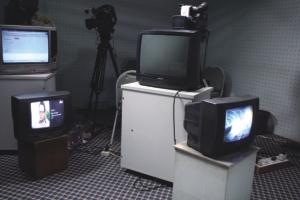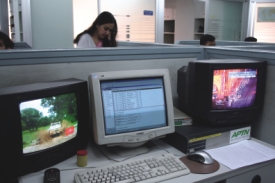| Cover
Story
 Bangladeshi TV Bangladeshi TV
Making Global Business Sense
Sharier Khan
On an icy cold New York evening when the streets wear a deserted look, the Bangladeshi cafes at Jackson Heights look heated. A couple of years back, this heat was generated by political debates. It's the live news broadcast from Dhaka that's warming up these joints.
On August 17, when bombs exploded across the country, nearly one thousand people crowded the streets around the Bangladeshi cafes to see the news live. The live broadcast of the recent anti-food adulteration drive was so impressive that people decided to refrain from buying any dry food of Bangladesh origin. They no longer wait for the Internet edition of Bangladeshi newspapers. Bangladeshi TV channels have changed their everyday way of life.
For Bangladeshi private television channel entrepreneurs including ntv and ATN, this means big business. Information is the latest export item.
"My day starts with the live news from ATN," says Seema Islam, a schoolteacher living in the area called Jamaica in New York city, "when I wake up, I turn on the TV and listen to the news while getting prepared for school. When I come back, I keep the TV on while I do my everyday chores. This has changed our way of life here."
This is true for almost every Bangladeshi immigrant--from a schoolteacher to a lawyer, or a businessman to a realtor. Hard-working immigrants, most of whom emigrated after the nineties cannot let go of their longing for everything Bangladeshi.
"The live TV broadcast brings Bangladesh to our homes," says Abdur Rahim, a businessman in Brooklyn. "I used to read the news everyday on the Internet two years back. But now I  watch TV. I know what is happening in Dhaka instantly and this makes me feel like I am there. When there is an incident like a bomb explosion, I instantly call up my family in Chittagong and check out if they are alright." watch TV. I know what is happening in Dhaka instantly and this makes me feel like I am there. When there is an incident like a bomb explosion, I instantly call up my family in Chittagong and check out if they are alright."
Most Bangladeshi adult immigrants, male or female, are hard-working and they spend a good part of their time outside the home. Often, lunch is at the Bangladeshi restaurants sprawling in different parts of New York from Jackson Heights to Manhattan. Many of these restaurants now host Bangladeshi TV channels on large screens, keeping in mind the interest of their customers.
"Sometimes the crowds do become too much to handle," says a restaurant manager in Jackson Heights who screens live ntv, "but that makes business good too."
TV executives say that the US market has a base of between 40,000 to 42,000 while the Bangladeshi channels have so far tapped only around 15,000 of them. Without any advertisement revenue, the total Bangla channel viewers alone can earn a TV channel 3,00,000 dollars monthly.
According to executives of various channels, such lucrative prospects have triggered TV channel entrepreneurs to consider US based programmes and special drives.
At present ntv leads the pack with a client base of more than 8000, followed by ATN's 4000 and Channel i's 2000. Both ntv and ATN are earning more than 40,000 US dollars each just from their client base and are now embarking on aggressive marketing.
ntv has the larger client base as it started broadcasting with a costly but mainstream cable network. On the other hand, ATN opted for its own slower but more profitable receiver system.
In addition to these three TV channels which are broadcast from Dhaka, there are some other Bangla TV channels -- London based Bangla TV, and New York based TBC and STV. Of these STV has been launched recently with a plan to cover New York based news.
ntv is operating in collaboration with Soundview Broadcasting, owned by a Pakistani American tycoon Shafqat Chowdhury. ntv owner Mosaddek Ali jointly with Chowdhury has pumped in around 12 million dollars, aiming at a total investment of 20 million dollars.
Viewership, like many things Bangladeshi, are divided along political lives. Some hardcore pro-Awami League viewers do not watch ntv because of the political identity of its owner, while some hardcore pro-BNP viewers do not like ATN believing it to be tilted to the Awami League.

At present ntv leads the pack with a client base of more than 8000 followed by ATN's 4000 and Channel I's 2000
ATN USA
ATN USA is a down-to-earth arrangement that operates independently on 37th Avenue Woodside of New York. It pioneered a live Bangladeshi TV broadcast in the USA on March 28, 2004 and started distributing its exclusive dish on globe cast satellite provider. "We had asked for a 300 dollar set up charge. Despite such high charges, we received tremendous response. We could not reciprocate with such high demand," says MJ Panir Bhuiyan, Director of ATN US at his office.
"For Bangladeshis here, this was like their real home coming inside their US homes. One would call up his mother back in Bangladesh and ask her, "have you seen that drama?" he adds.
In the next nine months, ATN provided only 3000 connections against the US-wide request of 10000. "This is a big country and it is very difficult to provide them with the connection," Panir pointed out.
By that time, ntv and Channel i had launched their operations and these channels claimed a good share of the market. "We had asked them to join us in the same transmission
 |
ATN USA is planning to move into a large studio this January |
system, but they did not agree. If we had come under the same platform, the market would have been very big for all of us. Each of the channels has their own hit programme. Many viewers do not like one particular channel for political reasons," he says. While ntv has launched an aggressive marketing drive, which includes first six months of free transmission, free installation and a free DVD player for each client, ATN is not far behind. "We are also going for an agreement with a major cable network in the USA which will expand our market within the next few months," Panir added.
Like ntv, ATN is also planning to go for time delay of its prime time programme for US viewers.
ATN USA is moving into a large studio this January and start modifying its programmes for the local audience within a few months. The ATN is also considering bringing in Bangladeshi journalists for six-month long stays to cover news.
"The situation demands each of the channels to have a 10 member team for the US operation. But there is an acute crisis of manpower here," Panir pointed out.
ATN has already received a good advertisement response from the US market. "Right now we have 55 advertisements and are broadcasting 20 of them. We did not accept  advertisements in the first year. We can run our US operations just from these advertisements alone. Earning from advertisements can shoot up to 100,000 dollars a month," he said. advertisements in the first year. We can run our US operations just from these advertisements alone. Earning from advertisements can shoot up to 100,000 dollars a month," he said.
Such a robust market has also triggered the establishment of ad-firms for Bangladeshi immigrants.
ATN Chairman Mahfuzur Rahman who was on a visit to New York in the third week of last month told The Daily Star that his channel invested a moderate one million dollars in the USA. "We don't believe in wild spending. And whatever we earn, the Bangladesh part will go to Dhaka in the official channel," Rahman noted.
ntv USA
Unless one pays a visit to the ntv New York office on the 37th Avenue, it would be difficult to believe that it is operating from a 78,000 sqft floor office under a joint venture with Soundview Broadcasting.
Vice President of Soundview Broadcasting Syed M Hossain says that his three-year company signed an agreement with ntv in April 2004 to bring in live news coverage. The ntv started live broadcasting through Dishnet from September last year.
Aiming at ethnic viewers, Soundview broadcasts eight different channels--mostly from the sub-continent. Of them, ntv is the lone news channel.
"The news published in the local Bangla newspapers do not reflect the actual news as these are highly politicised. Secondly, the immigrant Bangladeshis are concerned about maintaining their roots for the sake of their children. In this context ATN, Channel i and ntv came here," Hossain said at his New York office.
Along with an 8000 plus paid viewers base, ntv is also drawing local advertisements.
With quick success encouraging the investors, ntv now plans to generate US based community news, local programmes, local artists promotion, local advertisements and other programmes to specifically feed the US and Canadian audience.
Most importantly, ntv will implement a "time delay" for the US audience so that they get to see the prime time programmes at prime times. "Presently the broadcasts are live from Dhaka. The US audience has to see prime time programmes in the early morning when they have to leave for work," Hossain pointed out.

From December 16, ntv starts operating in Canada under its own license in collaboration with Canadian communications giant Rogers. To emphasise on its US network, ntv plans to send two journalists from Dhaka for a three- month term to cover news from New York. The ntv office even has the residential set up for this purpose.
The ntv New York office will hire five journalists for news and event coverage which will be telecast on a regular basis.
The ntv office under the banner of Soundview, is now being decorated and equipped with most modern audio and video recording, editing and broadcasting equipment. "We have our own news van, system for multimedia editing and to send news feed. We already have a New York correspondent," Hossain added.
The ntv US sends a large chunk of its earning to Dhaka through official channels, he claimed.
TV channels are focussing in the US market, says Hossain because most Bangladeshi immigrants have come to the USA after the nineties. "They have a great attachment to Bangladesh than the immigrants to European countries where they had gone decades back. Every year, the number of immigrants in the USA are increasing due to the DV programme," he said.
In future Soundview plans to launch operations in Bangladesh.
STV
Newly launched New York based education-oriented news TV channel STV is owned by Hannan Firoze, vice chancellor of the Stamford University. "Initially it will require a Tk 50 crore investment. I am investing this fund myself," says Firoze.
"But in total it will need 11 million dollars investment. Seven million as capital and three million for equipment and another million for miscellaneous expenditure," Firoze said.
STV launched its news operation from November 22 along with a team of 9 people.
Unlike ntv and ATN, STV is being broadcast for free. "But later at a time, we will have subscription and advertisements to cover the costs," he added.
"Outside the news, we will focus on education. We shall try to bring in guest lecturers from the American universities and spread the knowledge of the world. This will have a good appeal," he said.
 |
 |
Bangladeshi channels like ATN and ntv are targeting us because of the potential client base that consists of recent immigrants still attached to their motherland |
It is very important for immigrants to get the live news to know what's happening in Bangladesh |
Channel i
Channel i presently does not have its own set up in New York. As a result, it has a weak market base. But Channel i director Zahiruddin Mamun told The Daily Star during his visit to New York that his Channel is also planning to expand the market in the USA.
TV executives say that over the years, other than the USA, Channel i has established a good base in the middle east and ATN in London and Europe. ntv, ATN and Channel i are present in most continents except in South America.
They all say, this new phenomenon is like a bridge between expatriate Bangladeshis from Australia to Canada. It is also triggering new business opportunities.
The impact of Bangladeshi TV channels among the growing immigrant communities around the world has so far gone unrecorded by the people outside the electronic media. Judging by the phenomenal popularity of these channels it seems that the Bangladeshi media is yet to tap into the main business and communication potentials here. This is an undeclared media conquest by Bangladesh. If the media is allowed to grow in Bangladesh there will be no stopping it from making waves beyond its borders.
Copyright
(R) thedailystar.net 2006 |
